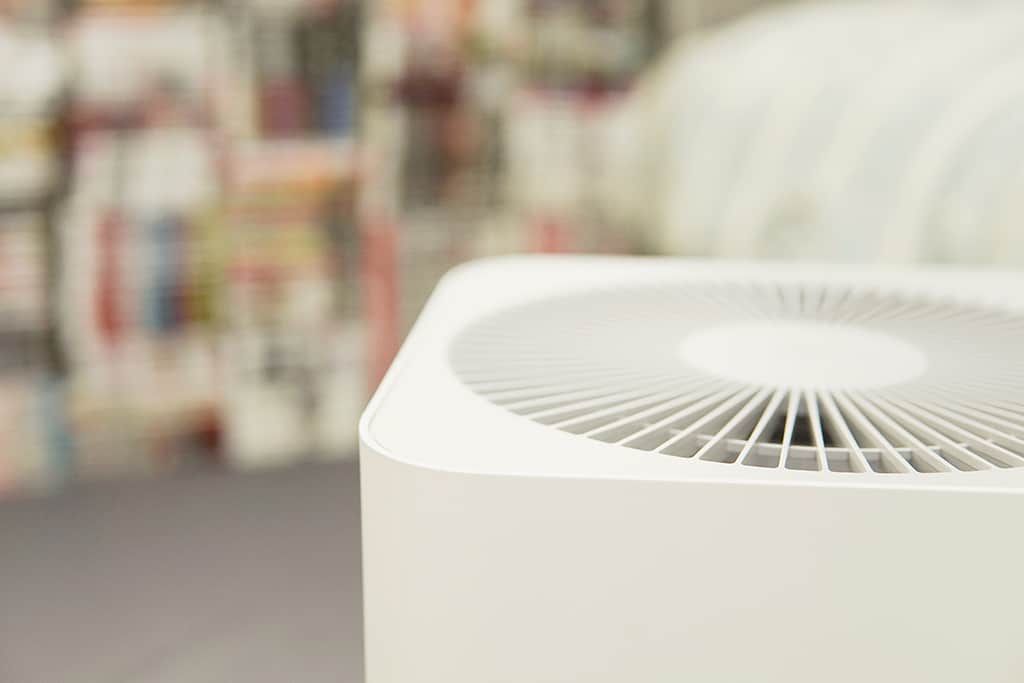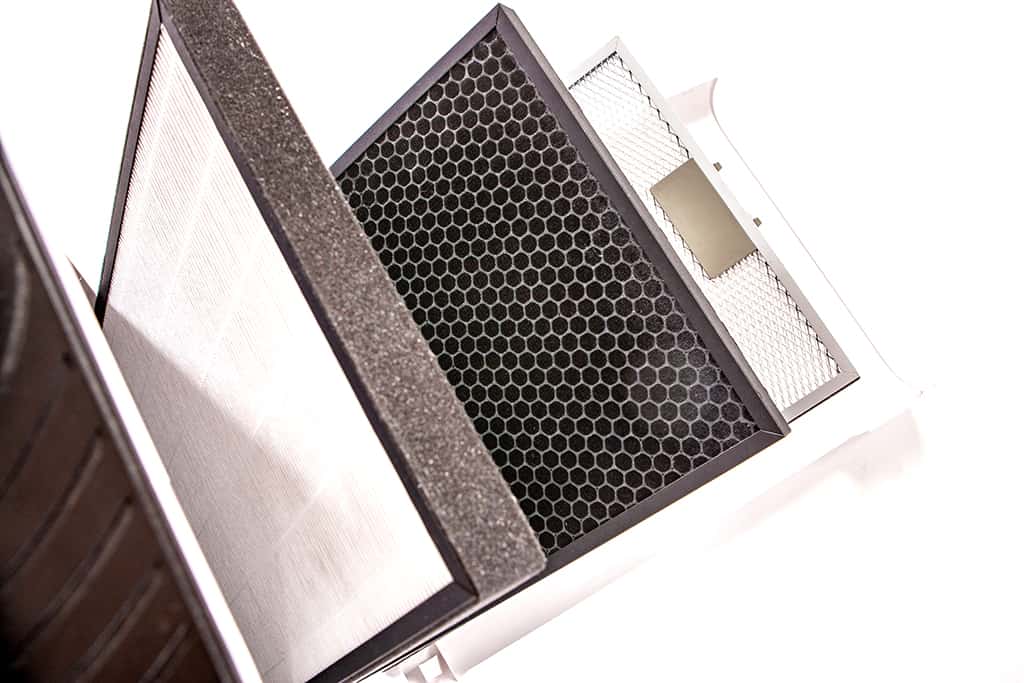We all want to live in the cleanest and healthiest environment we can, and our homes should be no exception. As a home owner you should be hyper-aware of how clean the air you breath is. Air purifiers help to remove odors, smoke, pet dander, and dust while leaving behind clean air to breathe.
That being said, air purifiers typically make noise and can be considered loud, annoying, and disruptive. Newer, quieter models aim to be effective without the sound. Let's explore some of these newer models and see how they stack up.
The Alen BreatheSmart air purifier is perfect for large rooms. It's capable of cleaning up to 800 square feet every 30 minutes, making it perfect for nurseries, living rooms, kitchens, etc.
The BreatheSmart features a True HEPA filter that's capable of capturing 99.97% of airborne particles as small as 0.3 microns. It also features a carbon filter that helps to capture smoke, household chemicals, volatile organic compounds (VOCs), mold, and more. The main filter lasts 9-12 months, and the pre-filter can be vacuumed to remove debris as needed.
Unlike most air purifiers, the BreatheSmart is designed to be space-saving. It has a rather small footprint; It's 2 feet tall and 15 inches wide. There are 7 color options available for the face-plate allowing it to fit in with your existing decor.
Noise output is kept to a minimum thanks to their WhisperMax technology. It was designed by a NASA engineer and only operates at 39-56 dB while using 50W at it's highest speed setting.
A few other notable features include:
Dyson is one of the most popular brands in the world. They're recognized for their innovations in both pulling air (vacuums) as well as blowing air (fans, purifiers, etc).
This particular purifier features a HEPA filter. While "True HEPA" isn't specified, Dyson notes that the filtration was tested to IEST RP CC001.5, international standard for HEPA. The test was also conducted by a third party (IBR Laboratories) to avoid bias.
The filter helps to remove 99.97% of allergens and airborne pollutants as small as 0.3 microns. There is also a second carbon layer in the filter that helps to capture volatile organic compounds (VOCs) and other household odors.
The Dyson Pure Cool is capable of delivering 77 gallons of purified air to the room thanks to the Air Multiplier technology. All while operating at whisper quiet levels.
The Pure Cool was awarded Quiet Mark accreditation. Quiet Mark is a third party that looks for the quietest products in any given category. However, sound levels (dB ratings) aren't specified.
A few other notable features:
The Coway air purifier has coverage for rooms up to 326 square feet. It has a contemporary design featuring a four-stage filtration system: pre-filter, deodorization (carbon), True HEPA, and vital ion.
As a result of the filtration, it's capable of reducing up to 99.97% of particles 0.3 microns in size. This includes particles like pollen, dust, and other allergens as well as odors and VOCs.
The Coway is capable of reporting back to the user in real-time about the indoor air quality. It also has a indicator light that tells the user when to change the HEPA filter and when to clean the pre-filter (washable).
All of this is possible through 3 fan speeds. It also features an auto mode that adjusts fan speed based on the level of indoor air quality. When no pollution is detected the fan will also shut-off and is set to ECO mode to save on electricity.
Operation in the various fan modes results in noise levels of 24.4 dB to 53.8 dB all while consuming 77W of power.
The Trustech Air Purifier features a three-stage filtration: Pre-filter, True HEPA, and Ions filter.
The system helps to remove 99.97% of particles as small as 0.3 microns and larger air pollution of PM 2.5. For example: odors, dander, smoke, pollen, and dust from your home.
The issue with a lot of Ion-based filters is that they release ozone as a by-product. Trustech notes that their air purifier is ozone free, meaning it's healthier for the environment and healthier for you.
The unit is portable, making it easy to move to any room in your house. It's square, compact nature allows you to place it on your floor, desk, tabletop, etc. However due to it's size, you're restricted to average-sized bedrooms or spaces of 161.46 sq.ft.
The purifier has three different speed settings: sleep, medium, and high. With that said, even at it's highest level of operation the noise level only reaches a maximum of 50 dB.
Operation is seamless thanks to features like "auto-mode" which allows it to detect air quality and adjust its speed accordingly. The purifier also features an automatic filter replacement reminder, so you know when to replace it.
This purifier is ready right out of the box. There's only 1 button to switch between speed modes and a button to turn the light off.
The LEVOIT air purifier is perfect for small/medium sized spaces of 161 square feet and works to recirculate air 3 times per hour.
It features a 3 stage filtration process: pre-filter, True HEPA, and a high efficiency activated carbon filter. This system helps to eliminate airborne particles, bacteria, dust, mold, odor, pet dander, and other VOCs.
In terms of efficiency, this air purifier is hard to compete with. When in operation it only consumes 0.9W of electricity. If you were to run the purifier 24 hours a day for a year, it would cost as little as $6.
There are only three fan speed settings: low, medium, and high. It also can operate based on timer settings of 2, 4, and 8 hours and will eventually auto shut-off.
These modes of operation result in sound levels of 26 dB to 52 dB. In sleep mode the purifier operates at whisper quiet levels of 26 dB thanks to it's brushless motor.
If you have children, you'll be happy to know it features a night light with two brightness levels. The light can also be turned off as they grow up.

In some cases the air quality in your home can be up to 5x more polluted(1) than the outdoors. This is especially concerning when most Americans spend a considerable amount of time inside. You start to see why it's important that your indoor air quality be improved.
Almost all air purifiers are different. They come with different features, shapes, sizes, and methods to clean air. Let's take a look at some of the most important features to consider.
For the most part, there are five reasons for why a person would get an air purifier:
An estimated 50 million Americans suffer from nasal and respiratory related allergies. Allergies are also the 6th leading causes of chronic illness in the United States(2).
According to the Centers for Disease Control and Prevention (CDC), 1 in 13 people have asthma(3).
One of the main contributors to asthma is polluted air. An air purifier is one of the best ways to clean indoor air and prevent respiratory related issues.
A lot of people smoke tobacco products like cigars and cigarettes. This type of odor can linger for a long period of time. Air purifiers featuring activated carbon filters can help to eliminate these smells.
As we pointed out above, allergies are a serious cause for concern. One of the major culprits for these allergies is pet dander. Another issue with indoor pets is that they shed hair that can build up on furniture.
An air filter can help to combat both pet dander and hair.
Mold spores can also be rather detrimental to your health. Many people even develop chronic illnesses as a result of mold exposure.
Luckily, specialized air purifiers do exist that can help to fight against mold and bacteria.
The second thing to consider is the size/coverage requirement for airflow.
Luckily, a formula to calculate the area of coverage is rather easy. First we need to become familiar with terminilogy:
Formula: CFM of the Air Purifier x 30 minutes (represents 2 ACH) / 8 (average ceiling height) = Area of Coverage
Suppose our air purifier has a CFM rating of 200 CFM. Putting this value into the formula above results in:
200 CFM x 30 minutes / 8 ft. = 750 square feet of coverage.

There a number of air purifiers available. However, they all can be categorized based on their method of filtration: HEPA, Ionic, Carbon, and Ultra Violet light.
High Efficiency Particulate Air (HEPA) filtration is the upper echelon of air purification. These types of filters are comprised of dense filter paper that can trap airborne pollutants.
While several products claim to use "HEPA" filters, you should only consider "True HEPA Filters." These filters are certified to meet standards set by the US Environmental Department.
Meaning it can remove 99.97% of all particles as small as 0.3 microns (That's 3 particles for every 10,000).
Ionic filters work by emitting charged ions into the air. These charged ions then latch onto airborne pollutants and particles. This causes the particles to then fall onto the floor and other surrounding surfaces.
There are some ionic air purifiers that also feature an electrostatic collection plate. This plates attracts these particles and helps to remove them from the room.
Carbon filters are especially effective against odors, chemical and gas fumes, and smoke. This is thanks to a special form of activated carbon that features tiny absorbent pores between carbon atoms.
However they are not particularly effective against airborne pollutants that cause respiratory issues.
If you're trying to minimize noise pollution in your home, taking the noise level into account is important.
As you might already know, all fans produce some form of audible noise. HEPA and Carbon filters both use a fan that's powered by a motor in order to pull air into the unit, through the filter, and is then exhausted.
Most air purifiers also come with speed settings. Typically they'll be some form of the following adjectives: slow, medium, high. There are also some that feature options like automatic or "auto."
As you might expect, the higher speed settings result in greater noise being produced. This is why sizing your room appropriately is important. If you buy an air purifier that's too small for your room, it will work harder, that is, the fan will spin faster.
If your goal is complete silence, an ionic based filter uses no fans or filters. However, ensure that the purifier you use creates negligible amounts of ozone and remains within regulatory limits.
Air purifiers help to remove dust, pollen, allergens, pet dander, and odors from your home, which improves the health and lives of those living with you.
In particular, air purifiers are beneficial for those suffering from allergies and asthma and other respiratory issues.
Picking an option is as simple as aligning yourself with the factors above.

Snoringsource.com is a participant in the Amazon Services LLC Associates Program, an affiliate advertising program designed to provide a means for website owners to earn advertising fees by advertising and linking to amazon(.com, .co.uk, .ca etc) and any other website that may be affiliated with Amazon Service LLC Associates Program.